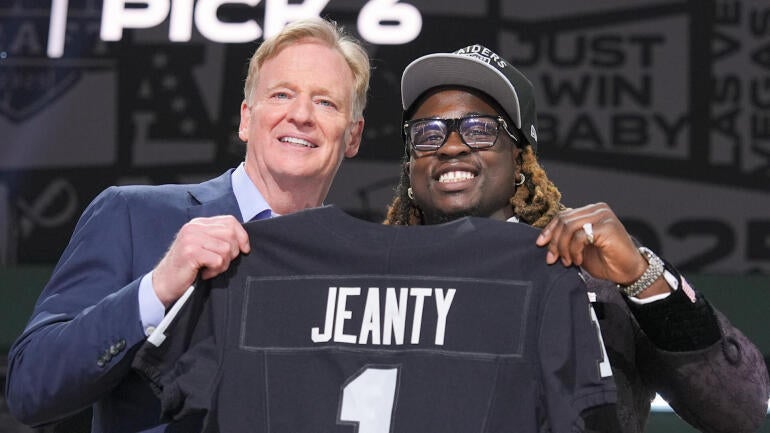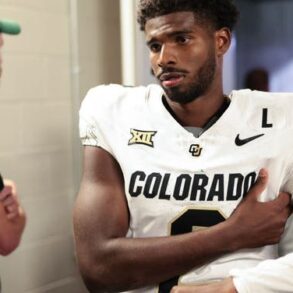
Today’s topic is layered. We’re gonna take it piece-by-piece.
As an end point, I’m focused on how the rookie RB class might acclimate to a new environment in the NFL. To get there, I think it’s important to first understand the topic of run schemes. If you’d rather skip straight to the player-specific takeaways, scroll to the bottom!
We’re talking about rush schemes today:
1. As it pertains to rushing, how does collegiate football differ from the NFL?
2. What is the difference between zone and man/gap rushing?
3. Which NFL teams specialize in specific rushing types?
4. How might the incoming rookies for those teams be affected?
USATSI
How does collegiate football differ from the NFL?
Gary A. Vasquez / USA TODAY Sports
I compiled some statistical differences between the 2024 NFL and CFB seasons below.
Percentage of RB runs with 8+ defenders at the line of scrimmage (stacked box):
28% – CFB
36% – NFL
Life is harder for a running back in the NFL.
Percentage of RB runs from the shotgun formation:
91% – CFB
48% – NFL
Even though CFB running backs averaged notably more yards per rush (5.1) than NFL running backs (4.4), the average rushing success rate was higher for the NFL running backs (45.4%) than CFB backs (42%).
A successful run on first or second down = a gain of at least half of the required yardage to first down
A successful run on third or fourth down = gaining a first down
Low success rate running backs usually don’t last long in the NFL. Generally speaking, it’s a no-nonsense league that rewards running backs who limit mistakes and maximize opportunities.
That’s not always the case, though. Some schemes emphasize creating big play opportunities, even at the expense of more negative plays. Outside zone runs had just a 42% success rate (NFL) in 2024. That was the lowest rate among run-type classifications on TruMedia, the data base that I use. Outside zone runs had one of the highest explosive run rates of any type of run, though!
No data point tells the whole story! Context is necessary in getting any closer to understanding or predicting an end point. In example:
The above tweet clearly seems positive in regards to Cam Skattebo and negative as it relates to Kaleb Johnson.
Awareness of Johnson’s vastly different run scheme helps to better understand some of his underwhelming metrics. Johnson’s outside zone rush rate at Iowa was more than twice as high as Skattebo’s rate at Arizona State. He also ran from the shotgun only 31% of the time! Remember that the CFB average was 91%!
The NFL and CFB run games are different, and not everything that worked in college is going to translate to the pros. Avoided tackle rates drop as competition level increases. At the collegiate level, avoided tackle rates are higher in non-Power 4 conference contests than in Power-4 games. Rates drop again from college to the pros.
Ashton Jeanty isn’t going to post an avoided tackle rate near 50% at the NFL level (he might). Yards before contact aren’t going to be as readily available. Light boxes aren’t going to present themselves as often. It’s a different game. Not every running back is built for it.
Which NFL teams specialize in specific rushing types?
Kyle Shanahan and the San Francisco 49ers are known as the modern school of outside zone rushing. While Sean McVay has reinvented himself as a run designer, not much has changed when it comes to the broad strokes of the Shanahan run game. 73% of San Fran’s RB rush attempts in 2024 were zone runs with a 54/19% split between outside/inside zone runs. Only one team had a higher outside zone run rate: the Atlanta Falcons.
Outside Zone Specialists:
(Highest percentage of RB runs coming from outside zone in 2024)
62% – Falcons
53% – 49ers
53% – Saints (Klint Kubiak will call plays for the Seahawks in 2025)
(Kellen Moore, the new Saints offensive designer, only used outside zone on 22% of RB rushes as Philly’s play-caller)
50% – Lions (Ben Johnson will call plays for the Bears in 2025)
(John Morton, the new Lions offensive coordinator, was the passing game coordinator for Denver in 2025. I’d be surprised if Detroit implemented significant changes to the run game)
47% – Texans (Nick Caley, the new Texans OC, was the Rams tight ends coach and pass game coordinator)
46% – Dolphins
45% – Jets
40% – Vikings
Mixed Zone Specialists
Panthers — 43% outside zone, 22% inside zone
Steelers — 40% outside zone, 29% inside zone
Browns — 34% outside zone, 24% inside zone
Cowboys — 27% outside zone, 37% inside zone
Chiefs — 22% outside zone, 37% inside zone
Eagles — 22% outside zone, 34% inside zone
Inside Zone Specialists
There were really only two inside zone specialists, and one is out of a job (Jacksonville). The one who remains an NFL play-caller is Kliff Kingsbury. The Washington Commanders used inside zone at the NFL’s third-highest rate (35%) of RB runs, but only registered a 13% outside zone rate.
Getty
Man/Gap Specialists
Only one team had a man/gap run rate above 40% in 2024, and it was the same team that led the NFL in man/gap RB run rate at over 50% in 2023.
Rams — 43%
Bills — 38%
Giants — 37%
Bengals — 36%
The Bills had a 10% ‘power’ run rate, which is included in the total man/gap rate. Compare that to the Rams, who had just a 2% power rate. What made up the vast majority of the 43% man/gap run rate, then?
If you watched the Football 101 videos that I linked, you’ll recognize ‘duo’ as a man/gap run classification. That’s become the bread and butter for McVay and Kyren Williams. The below excerpt was pulled from last summer’s FFT newsletter.
The Rams and Bills are the only two teams to post a rushing success rate of 48% or better on RB runs in each of the past two seasons. Those are the two most man-heavy run schemes in the NFL. Coincidence? I think not!
I don’t mean to imply anything about which scheme is “best.” More so, I hope to drive home the point about man/gap running being so much different than outside zone running. Remember the point made about Kaleb Johnson, earlier? Outside zone running swings for the fences at the expense of strikeouts, while man/gap running works the count, puts runners on base, and is content with piling up singles and doubles.
Like McVay, other offshoots from the Shanahan tree are implementing more man/gap rushing. While remaining true to their outside zone roots, both Matt LeFleur and Kevin O’Connell increased their man/gap run rates in 2024. The Packers were one of five teams with a rush success rate above 50% on RB runs last year, thanks in part to more of a bully-ball approach.
Both the Vikes and Packers beefed up the O-Line this offseason and could lean even more into a mixed rushing approach. You probably aren’t here to think about Jordan Mason and Aaron Jones, though. Let’s get to these rookies and get outta here! I’ve given you a lot to chew on in this newsletter. We’ll spend more time with the topic of rush schemes later this offseason.
Below, you’ll find the man/zone splits for the qualified incoming rookie backs.
How might incoming rookie RBs be affected by schematic fit?
You can find out which rookie running backs from the 2025 NFL Draft class are most affected by scheme fit and where you should be drafting each prospect by signing up for the Fantasy Football Todays newlsetter. That content and much more will be available in the newsletter three times per week. It will be exclusive to the newsletter.
You can sign up here.
This post was originally published on this site be sure to check out more of their content.





